Key takeaways:
- Ocean science education thrives on emotional connections and hands-on experiences, fostering curiosity and a sense of stewardship among students.
- Engaging strategies, such as storytelling, interactive learning, and project-based activities, effectively enhance students’ understanding and interest in marine ecosystems.
- Creating immersive learning environments, including sensory and tactile experiences, can significantly deepen students’ emotional connections to ocean science.
- Measuring student engagement through surveys, observations, and reflective journals provides valuable insights into their interest and emotional investment in the subject.
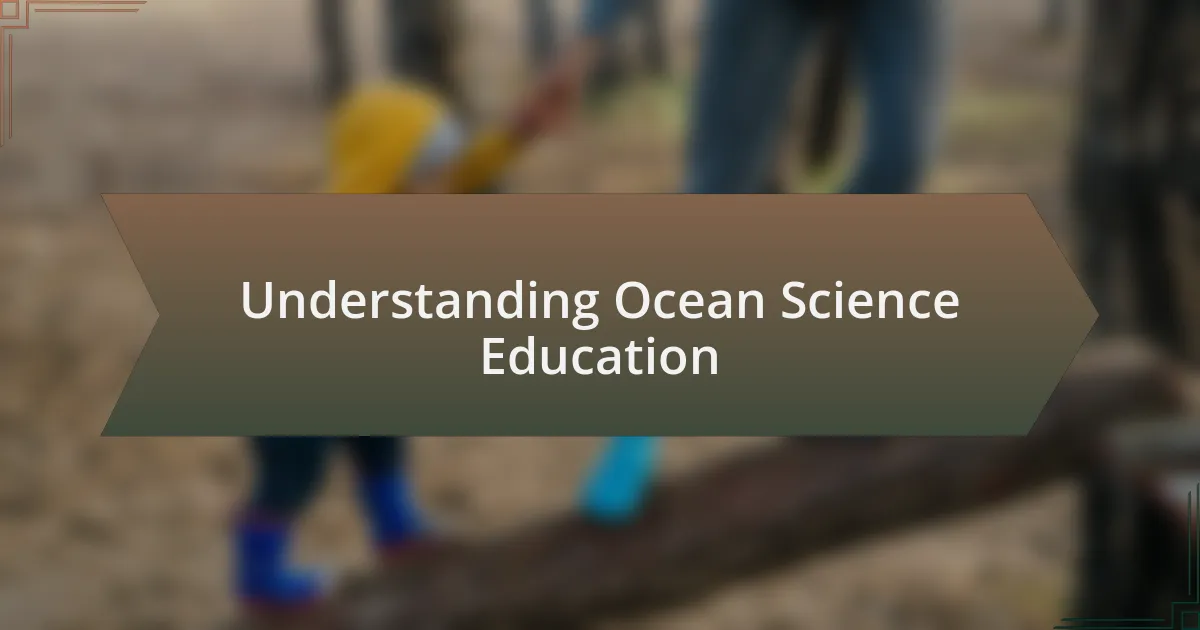
Understanding Ocean Science Education
Ocean science education is a captivating field that plays a crucial role in developing our understanding of marine ecosystems. I remember the first time I took a group of children to the beach for a hands-on learning experience. Their faces lit up when they discovered tiny crabs scuttling across the sand, and it struck me how tangible interactions with nature spark curiosity and inspire a desire to learn more.
As I delve deeper into teaching ocean science, I’ve found that understanding the ocean is not just about facts and figures; it’s about connecting emotionally with the environment. Why do we care about protecting these magnificent bodies of water? My own affinity for the ocean grew from countless afternoons spent tide-pooling with friends, which cultivated a sense of stewardship I hope to instill in my students. It’s in these moments of wonder that we can foster a profound and lasting appreciation for marine life.
Effective ocean science education calls for creativity and engagement. I often integrate storytelling into my lessons, weaving narratives about ocean creatures and their habitats. This approach not only makes the information more relatable but also prompts students to imagine themselves in these underwater worlds. Have you ever considered how a story can unlock a child’s imagination and deepen their understanding of the importance of ocean conservation? Through these experiences, I’ve witnessed firsthand the power of storytelling in shaping young minds.
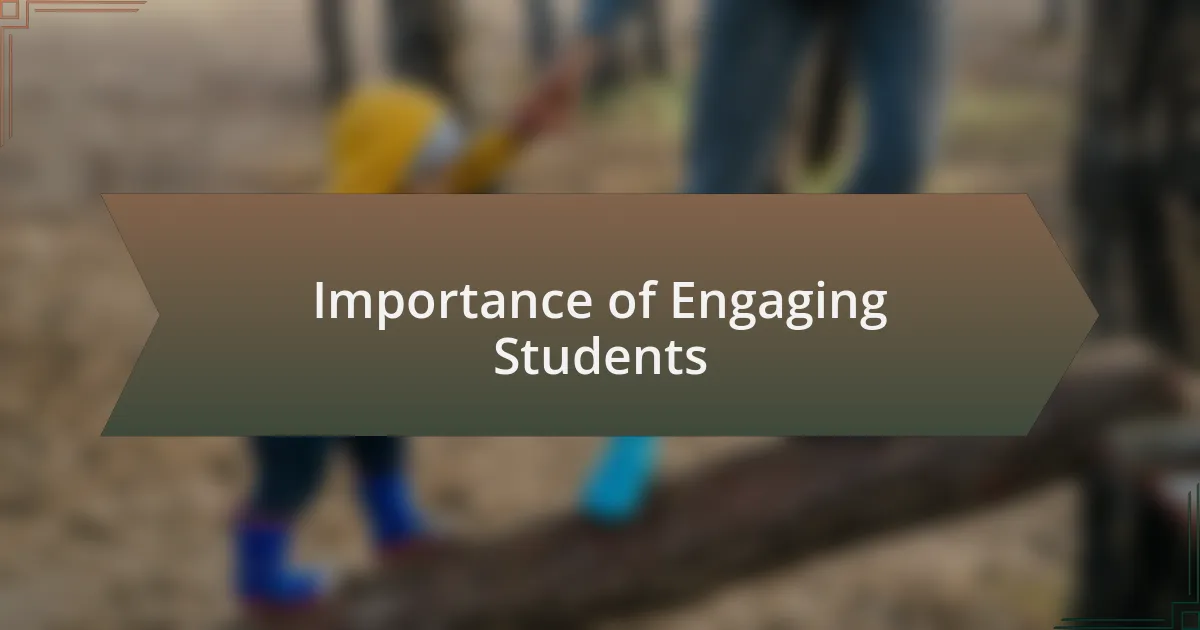
Importance of Engaging Students
Engaging students in ocean science is vital for nurturing their innate curiosity. Early in my journey as an educator, I organized an interactive session where students created their own ocean dioramas. This hands-on activity not only deepened their understanding of marine habitats but also allowed them to express their creativity. Isn’t it incredible how active participation can transform knowledge from mere words into vivid experiences?
The emotional connection students build with ocean science can ignite passions that last a lifetime. I recall a moment when a student shared how a lesson on coral reefs inspired them to dream of becoming a marine biologist. Hearing those aspirations made me realize the significance of engagement — it not only fosters knowledge but also can shape career paths and lifelong commitments to environmental stewardship. How often do we underestimate the power of inspiration?
Ultimately, engaging students isn’t just about learning facts; it’s about instilling values and a sense of responsibility. When I witnessed a class of fifth graders rally together to create a mini beach clean-up event after studying ocean pollution, it was a heartwarming reminder of the impact that engagement can have. Curiosity leads to action, and action brings about change. In what ways do you think active involvement can shape the next generation’s approach to environmental issues?

Strategies for Interactive Learning
Interactive learning harnesses the power of engagement to make ocean science accessible and exciting. I found great success in using role-play activities, where students act out different marine creatures’ roles in their ecosystem. Watching their laughter as they mimicked whale songs or incorporated the movements of sea turtles was a joyful reminder of how active participation makes complex topics tangible. Have you ever seen how much more relatable science becomes when students can step into the shoes — or fins — of living beings?
An effective strategy I employed was project-based learning, where students conducted their own research on local marine environments. I vividly remember a group focusing on the local tide pools, immersing themselves in data collection and analysis. The pride they exhibited when they presented their findings to the class was heartwarming. It validated their hard work and underscored the importance of their contributions. Can you recall a time when you felt that rush of accomplishment after sharing your discoveries?
Finally, incorporating technology into lessons can ignite a spark of curiosity. For instance, I introduced virtual reality experiences that allowed my students to dive into coral reefs from the classroom. The gasps of awe when they encountered vibrant marine life were unforgettable. This approach not only captivated their attention but also encouraged meaningful discussions regarding conservation. Have you experienced the magic of technology bringing the ocean closer to those who otherwise might never see it?
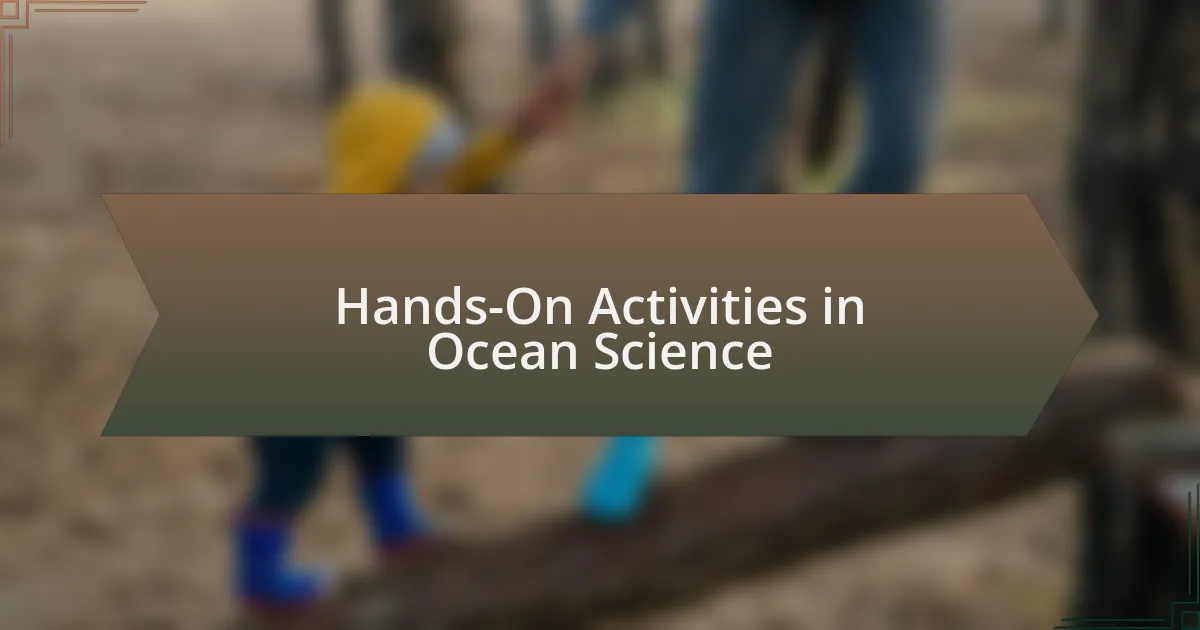
Hands-On Activities in Ocean Science
One of my favorite hands-on activities in ocean science involved creating a mini marine ecosystem in plastic tubs. We filled them with sand, rocks, and seaweed, then added small creatures like snails and crabs. Watching the students carefully observe how these organisms interacted with their environment was a delight. I remember one child exclaiming, “Look! The crab is hiding under the rock!” It was a simple yet powerful way to spark curiosity and invite questions about biodiversity.
Another engaging activity was a water quality testing experiment where students collected samples from a nearby beach. They got to measure pH levels, salinity, and even observe tiny plankton under microscopes. That moment when a student declared, “This water is muddy because of the rain!” showed their newfound understanding of how environmental factors affect marine life. They were connecting real-world observations to scientific concepts, and the excitement in their voices was truly inspiring.
Art can also play a crucial role in hands-on learning. I encouraged my class to create ocean-themed artwork using recycled materials. One student crafted a vibrant coral reef while another designed a colorful fish mobile. As they transformed trash into treasures, I witnessed a powerful shift in their understanding of ocean pollution and conservation. Have you ever seen how creativity can elevate awareness and foster a sense of responsibility toward the ocean?

Creating an Immersive Environment
Creating an immersive environment for ocean science goes beyond simply presenting information; it’s about enveloping students in experiences that spark their curiosity. I recall transforming my classroom into an underwater world, complete with blue fabric draping the walls and posters of marine animals hanging from the ceiling. As soon as students stepped in, their eyes widened, and I could almost hear their minds whirling with possibilities. How could such a simple change make such a big impact?
To further enhance this atmosphere, I integrated sensory elements like sounds of ocean waves and marine life sounds playing softly in the background. It was fascinating to observe how these auditory cues ignited conversations among students about their own experiences at the beach. One child shared a vivid memory of collecting shells, prompting a discussion about different shell types. I was thrilled to see them so engaged; it’s incredible what a little creativity can do to immerse young minds in ocean science.
I found that incorporating tactile experiences was equally essential in creating this enriching environment. I organized a station with sand, shells, and even some safe ocean-themed toys, allowing students to feel and connect with the ocean’s essence. Watching their faces light up as they sifted through the sand, discovering hidden treasures, reminded me of my own childhood explorations. Isn’t it amazing how touch can deepen understanding? By creating an immersive space, we not only teach about the ocean but also help students forge emotional connections that last a lifetime.
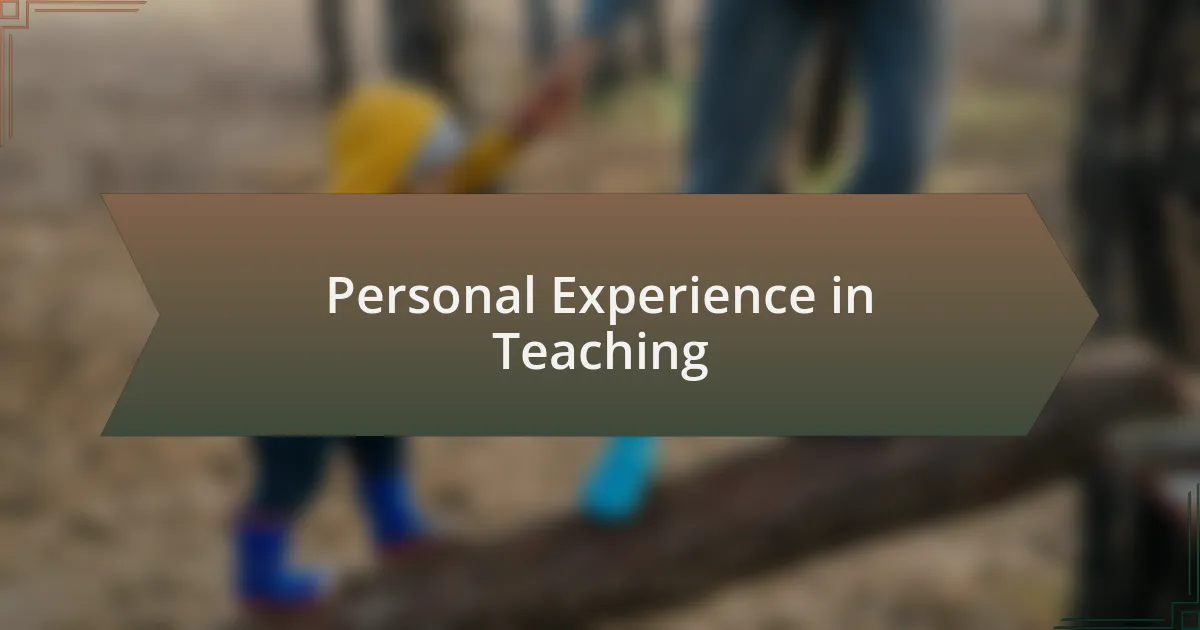
Personal Experience in Teaching
When I first began teaching ocean science, I quickly realized how vital it was to connect with my students on a personal level. One afternoon, during a lesson on coral reefs, I shared my own experience snorkeling in a vibrant coral garden. The awe I felt as schools of colorful fish darted around me ignited a similar spark in my students. I could see their imaginations taking flight, and it made me wonder—how often do we share our own stories to inspire curiosity?
Another memorable moment came during a project where students created dioramas of marine ecosystems. I remember one child painstakingly crafting a miniature tide pool, complete with seaweed made from green construction paper. The pride on her face as she presented her work was palpable. It struck me that these projects not only allowed them to express creativity—they also turned abstract concepts into tangible experiences. Isn’t it remarkable how art can serve as a bridge to deeper understanding?
Teaching is not just about delivering information; it’s about fostering connections. I once facilitated a field trip to a local aquarium, where students got to observe sea turtles up close. Many of them were genuinely moved by the experience, asking questions like, “What can we do to help protect them?” Witnessing their passion reminded me that it’s these moments of connection that make teaching worthwhile. How can we harness those feelings to inspire positive action in the world?
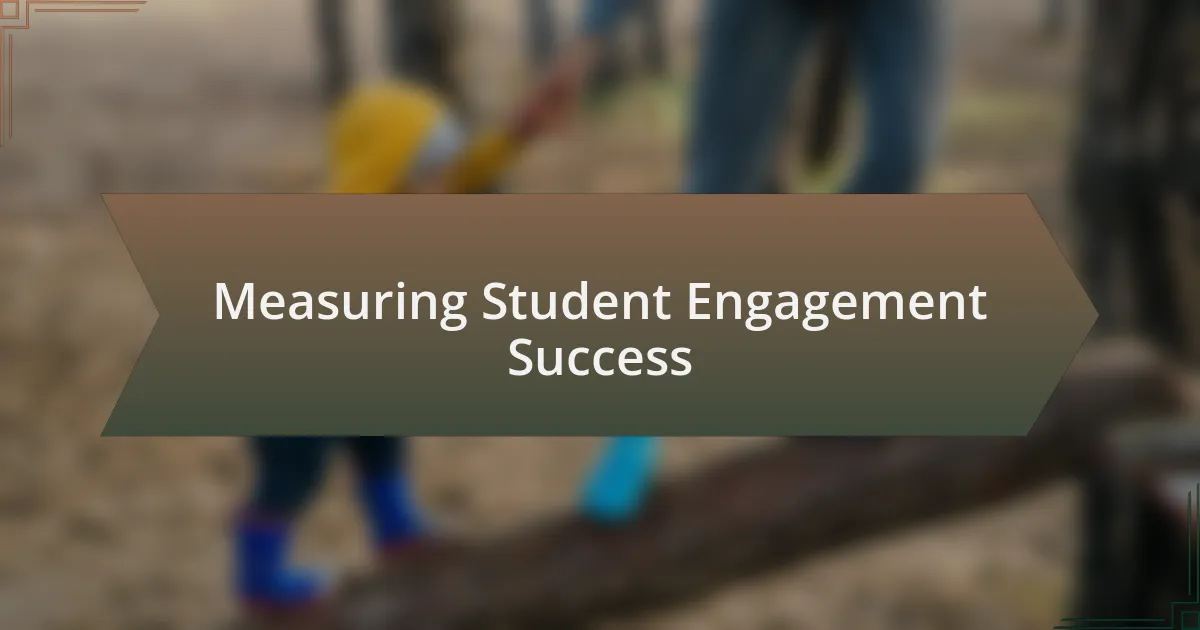
Measuring Student Engagement Success
Measuring student engagement is crucial for understanding how effectively I connect ocean science concepts to my students. I recently utilized a simple survey after a unit on marine biodiversity. The results surprised me: 85% of my students expressed excitement about learning more, affirming that hands-on activities, like our tide pool project, sparked their interest. It made me reflect—are we measuring not just attendance, but genuine engagement?
Additionally, I often observe their body language and participation during discussions. I recall a moment when a student, normally quiet, animatedly shared her thoughts on ocean conservation after our class debate. This shift revealed a deepening connection to the subject matter, prompting me to ask myself—how can we create more opportunities for students to express their enthusiasm?
I’ve also implemented reflective journals, where students can express their feelings about what they learned each week. Reading their entries, I found themes of wonder and curiosity jumping off the page, like a child describing their first encounter with a dolphin. This not only helped me gauge their emotional investment but also reinforced my belief that emotional engagement is a key indicator of their success. How can we further enhance methods to capture these invaluable insights?